Austevoll Seafood Bundle
How Did Austevoll Seafood Become a Global Seafood Powerhouse?
Dive into the compelling Austevoll Seafood SWOT Analysis and explore the remarkable journey of Austevoll Seafood, a leading Norwegian seafood company. From its humble beginnings in 1981 as a family-owned fishing venture, Austevoll Seafood has transformed into a globally integrated enterprise. Discover the strategic decisions and pivotal moments that have shaped its impressive trajectory within the dynamic world of Norwegian seafood and international fisheries.
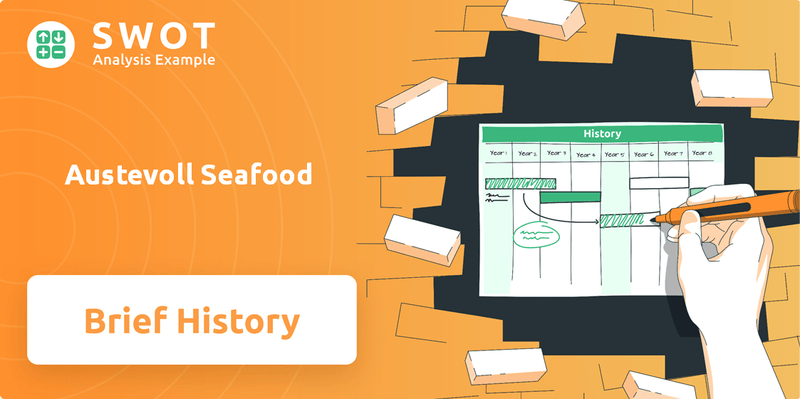
This brief history of Austevoll Seafood illuminates its evolution from a local operation to a major player in the aquaculture and fishing industries. Learn about the key milestones, strategic expansions, and financial performance, including its impressive Q1 2025 operating revenue. Understanding the Austevoll Seafood origin story provides valuable insights for investors, business strategists, and anyone interested in the seafood company's impact on the fishing industry and its commitment to sustainability.
What is the Austevoll Seafood Founding Story?
The brief history of Austevoll Seafood company begins in 1981, marking its establishment as Austevoll Havfiske AS. This Norwegian seafood company's origin story is rooted in the vision of brothers Helge and Ole Rasmus Møgster, along with their father Alf Møgster. Their venture into the fisheries industry was driven by a deep connection to the sea and a commitment to sustainable practices.
The founders, deeply rooted in the fishing traditions of Austevoll, Norway, saw an opportunity to build a business in the pelagic fisheries. Their initial focus was on fishing operations, setting the stage for what would become a significant player in the global seafood market. The company's growth reflects a strategic approach to both resource management and market expansion.
The company's early years were characterized by a commitment to growth and strategic investments. In 1991, a pivotal moment arrived with the purchase of a second fishing vessel, which included a valuable fishing license. This move signaled the company's intent to expand beyond its initial local operations. That same year, Austevoll Seafood also ventured into the pelagic market in Chile, accepting an invitation from EWOS to operate their fishing vessels, diversifying its geographical scope. The company's initial funding was likely private, given its family-owned structure. Austevoll Seafood ASA went public on the Oslo Stock Exchange in October 2006.
Austevoll Seafood's journey from a small fishing operation to a global seafood company is marked by several key milestones.
- 1981: Austevoll Havfiske AS is established by the Møgster family.
- 1991: Acquisition of a second fishing vessel and expansion into the Chilean pelagic market.
- 2006: Public listing on the Oslo Stock Exchange.
- The company has consistently focused on sustainable fishing practices and strategic acquisitions to expand its operations and market presence. For more insights, you can read about the Marketing Strategy of Austevoll Seafood.
Austevoll Seafood SWOT Analysis
- Complete SWOT Breakdown
- Fully Customizable
- Editable in Excel & Word
- Professional Formatting
- Investor-Ready Format
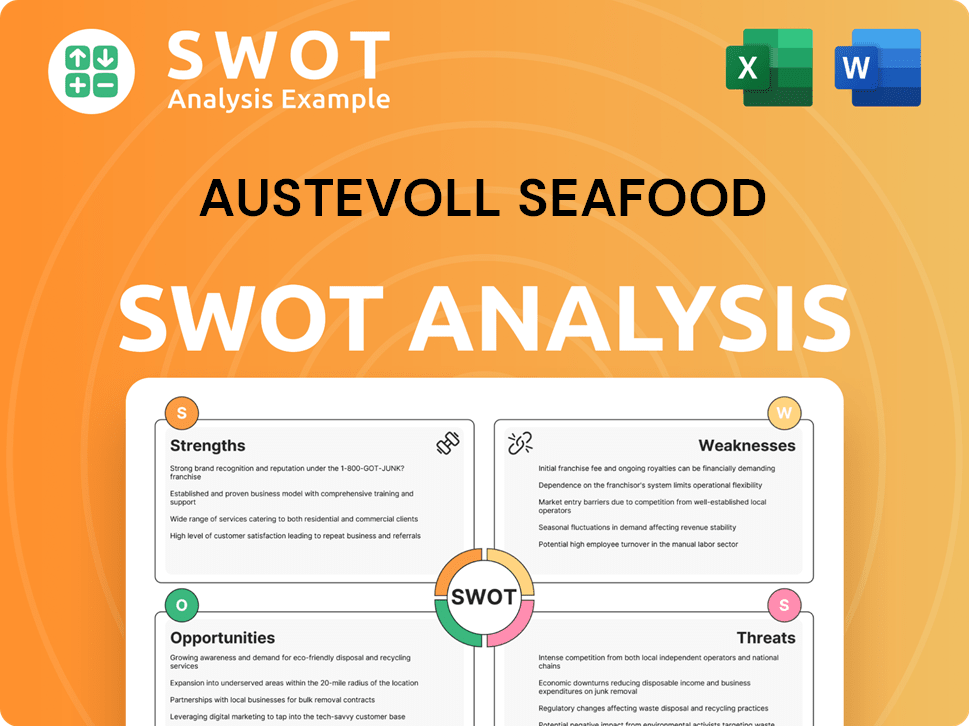
What Drove the Early Growth of Austevoll Seafood?
The early years of Austevoll Seafood, following its establishment, were marked by strategic expansion. This growth phase involved key acquisitions and partnerships that significantly broadened its scope. These moves helped cement its position in the global seafood market.
In 1991, a pivotal year for the Austevoll Seafood company, marked the acquisition of a second fishing vessel. This was coupled with securing a crucial fishing license in Norway. Simultaneously, the company ventured into the Chilean pelagic market, initially operating fishing vessels for EWOS, which expanded its presence in South America. This early expansion set the stage for future growth in the fisheries sector.
Austevoll Seafood's entry into the Chilean market was a strategic move, starting with operations in the pelagic sector. They gradually increased their footprint in South America. Today, the company controls approximately 8% of Chile's horse mackerel quotas, demonstrating its significant presence in the region's fisheries.
A major expansion phase occurred in 2006, with significant investments in the fishmeal and fish oil industry. This included the acquisition of Welcon Invest AS in Norway and Austral Group S.A.A. in Peru. These acquisitions expanded Austevoll's operations to include pelagic wild catch, and the production of fishmeal, fish oil, and canned products in Peru.
In 2007, the company strategically transferred its farming activities to Lerøy Seafood Group ASA. By 2009, Austevoll Seafood held just under 34% ownership, and currently holds a majority stake. This move diversified their portfolio into salmon farming, making them a leading producer in this segment, further expanding the company's aquaculture operations.
Further consolidation and growth in Europe took place in 2014, when Austevoll Seafood and Kvefi AS merged their pelagic activities. This resulted in the establishment of Pelagia Holding AS. Pelagia became a key player in the production of fishmeal, fish oil, Omega-3 oil, and frozen fish for human consumption. This demonstrates the company's focus on market consolidation.
The company's operating revenue for Q1 2025 reached NOK 9,793 million, a 17% increase from the previous year. Adjusted EBITDA was at NOK 1,938 million, highlighting continued strong financial performance in its growth phase. These figures underscore the company's sustained success and strategic expansion in the Norwegian seafood and global markets.
Austevoll Seafood PESTLE Analysis
- Covers All 6 PESTLE Categories
- No Research Needed – Save Hours of Work
- Built by Experts, Trusted by Consultants
- Instant Download, Ready to Use
- 100% Editable, Fully Customizable
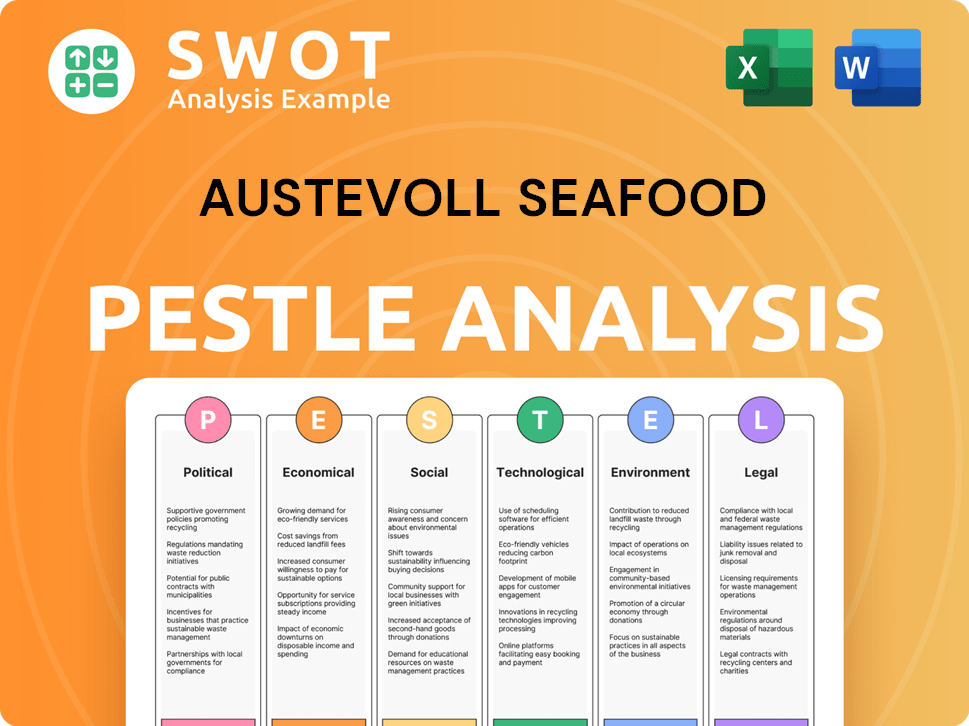
What are the key Milestones in Austevoll Seafood history?
The brief history of Austevoll Seafood is marked by significant achievements and strategic growth within the Norwegian seafood industry. The company's journey reflects a commitment to sustainable practices and operational excellence, establishing its position as a key player in the global fisheries and aquaculture sectors.
| Year | Milestone |
|---|---|
| Ongoing | Focus on operational efficiency and strategic adjustments, including increasing profitability in Value Added Production, Sales & Distribution (VAPS&D). |
| 2023 | Lerøy Seafood Group, a subsidiary, recognized for emission cuts in line with the Paris Agreement. |
| 2024 | Lerøy aims to be number one in the Coller FAIRR Protein Index. |
| 2025 (Target) | Aiming to reduce mortality in salmon farming and improve biological performance. |
Austevoll Seafood has consistently embraced innovation, particularly through its integrated business model. This approach spans fishing, processing, and sales for pelagic fish, whitefish, and salmon, ensuring product freshness and quality.
The company's fully integrated model, from fishing vessels to sales, ensures control over the entire value chain. This integration allows for enhanced quality control and efficiency in operations.
Austevoll Seafood prioritizes sustainable harvesting practices, adhering to international standards. This commitment supports long-term resource management and environmental responsibility.
The company focuses on value-added processing to enhance product offerings and profitability. This includes advanced processing techniques to meet consumer demands.
Austevoll has a leading approach to antibiotics in its aquaculture operations, with a target of zero antibiotic use by 2021. This initiative supports consumer health and environmental sustainability.
Despite its successes, Austevoll Seafood faces several challenges. The seafood company history includes dealing with volatile earnings and environmental issues within the aquaculture sector.
The seafood industry is inherently prone to earnings volatility due to fluctuating prices and supply. Salmon farmers, in particular, often face price-taker dynamics.
Environmental factors and disease outbreaks, such as sea lice and winter wounds, pose significant challenges in aquaculture. These issues can increase operational costs.
Geopolitical tensions and economic instability, such as the impact of the Russia-Ukraine war, affect financial markets. These factors contribute to challenging business conditions.
New governmental policies, such as the resource rent tax on sea-based salmon and trout production in Norway, impact tax strategies and financial reporting. This requires strategic adjustments.
In Q1 2025, the wild catch segment faced challenges with total catch volume decreasing to 19.0 thousand tonnes from 24.1 thousand tonnes in Q1 2024. Expected quota reductions will impact operations.
High costs of raw materials in the whitefish sector present a challenge. Addressing these costs is crucial for maintaining profitability.
Austevoll Seafood Business Model Canvas
- Complete 9-Block Business Model Canvas
- Effortlessly Communicate Your Business Strategy
- Investor-Ready BMC Format
- 100% Editable and Customizable
- Clear and Structured Layout
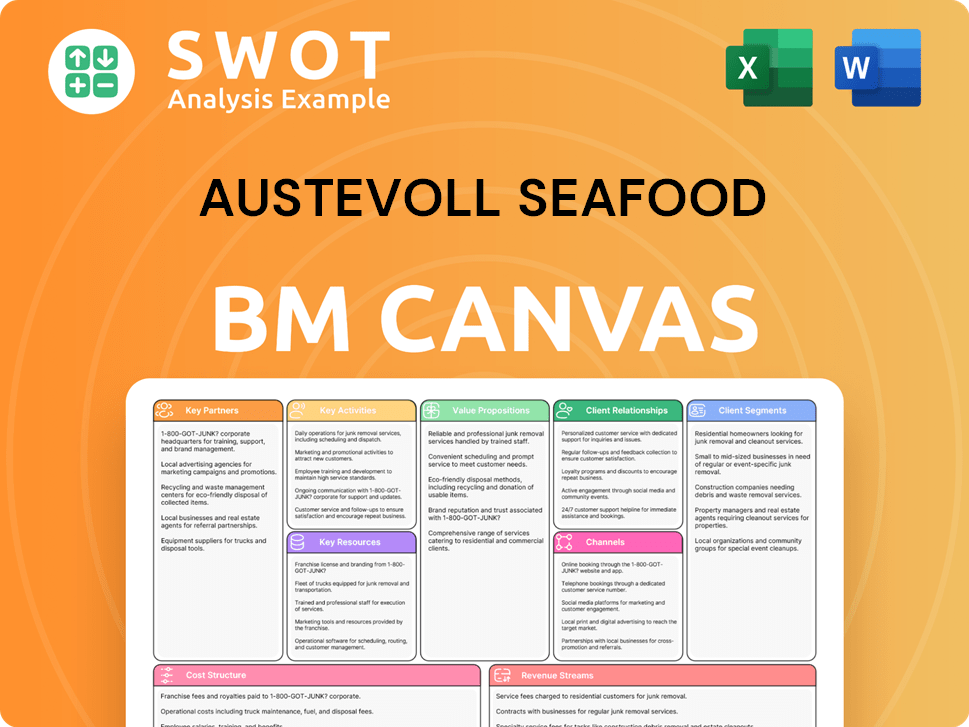
What is the Timeline of Key Events for Austevoll Seafood?
The history of Austevoll Seafood is marked by strategic expansions and adaptations within the global seafood market. Established in 1981, the company has grown from its origins in Norwegian fisheries to a diversified international player. Key milestones include acquisitions in Chile and Peru, entering fishmeal and fish oil production, and strategic partnerships in aquaculture. The company has demonstrated resilience and growth, especially in recent years, adapting to global challenges and market dynamics.
| Year | Key Event |
|---|---|
| 1981 | Established as Austevoll Havfiske AS in Austevoll, Norway, by Alf, Helge, and Ole Rasmus Møgster. |
| 1991 | Entered the pelagic market in Chile and purchased a second fishing vessel in Norway. |
| 2006 | Acquired Welcon Invest AS (Norway) and Austral Group S.A.A. (Peru), and listed on the Oslo Stock Exchange. |
| 2007-2009 | Transferred farming activities to Lerøy Seafood Group ASA and increased ownership to 63.7% by 2009. |
| 2010 | Became the largest shareholder of Domstein ASA. |
| 2011 | Merger between Austevoll Fisk AS and Norway Pelagic AS integrated pelagic operations for human consumption. |
| 2014 | Merged European pelagic activities with Kvefi AS, establishing Pelagia Holding AS. |
| 2022 | Reported a record year with EBITDA over NOK 6.8 billion. |
| Q4 2024 | Reported increased revenues and earnings, driven by strong operations in Peru and Chile. |
| Q1 2025 | Achieved operating revenue of NOK 9,793 million and adjusted EBITDA of NOK 1,938 million; recommended a dividend of NOK 6.50 per share. |
The global seafood market is projected to increase from $252.67 billion in 2024 to $270.43 billion in 2025, with a CAGR of 7.0%. This growth is driven by rising global population and increased demand for food, creating opportunities for companies like Austevoll Seafood.
Austevoll Seafood anticipates significant increases in its salmon/trout volume, expecting to grow from 44,000 GWT to 219,000 GWT in 2025. Lerøy's farming volumes are projected to reach 211.0 thousand tonnes in 2025, up from 171.1 thousand tonnes in 2019.
The company's strong balance sheet, with total assets of NOK 53,023 million and an equity ratio of 55% as of Q1 2025, supports future development. They are focusing on climate risk and ensuring future growth is financially and environmentally sustainable.
Austevoll Seafood expects global salmon prices and demand for fishmeal and fish oil to remain strong through 2026. Despite mixed fishing quotas in the North Atlantic for 2025, the company anticipates strong operating cash flows from its subsidiaries.
Austevoll Seafood Porter's Five Forces Analysis
- Covers All 5 Competitive Forces in Detail
- Structured for Consultants, Students, and Founders
- 100% Editable in Microsoft Word & Excel
- Instant Digital Download – Use Immediately
- Compatible with Mac & PC – Fully Unlocked
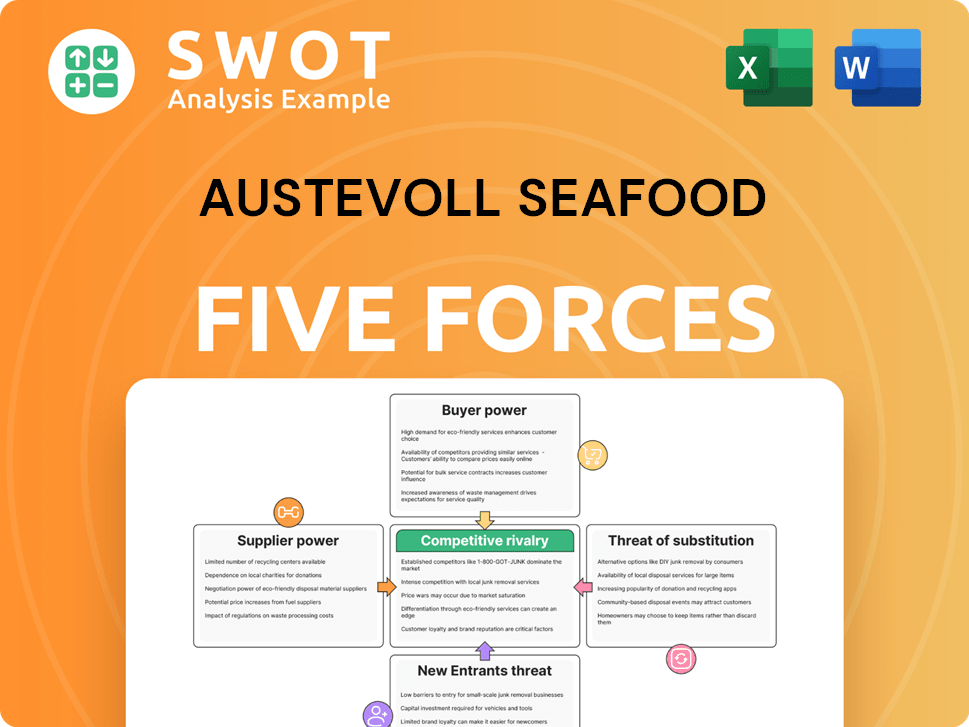
Related Blogs
- What is Competitive Landscape of Austevoll Seafood Company?
- What is Growth Strategy and Future Prospects of Austevoll Seafood Company?
- How Does Austevoll Seafood Company Work?
- What is Sales and Marketing Strategy of Austevoll Seafood Company?
- What is Brief History of Austevoll Seafood Company?
- Who Owns Austevoll Seafood Company?
- What is Customer Demographics and Target Market of Austevoll Seafood Company?
Disclaimer
All information, articles, and product details provided on this website are for general informational and educational purposes only. We do not claim any ownership over, nor do we intend to infringe upon, any trademarks, copyrights, logos, brand names, or other intellectual property mentioned or depicted on this site. Such intellectual property remains the property of its respective owners, and any references here are made solely for identification or informational purposes, without implying any affiliation, endorsement, or partnership.
We make no representations or warranties, express or implied, regarding the accuracy, completeness, or suitability of any content or products presented. Nothing on this website should be construed as legal, tax, investment, financial, medical, or other professional advice. In addition, no part of this site—including articles or product references—constitutes a solicitation, recommendation, endorsement, advertisement, or offer to buy or sell any securities, franchises, or other financial instruments, particularly in jurisdictions where such activity would be unlawful.
All content is of a general nature and may not address the specific circumstances of any individual or entity. It is not a substitute for professional advice or services. Any actions you take based on the information provided here are strictly at your own risk. You accept full responsibility for any decisions or outcomes arising from your use of this website and agree to release us from any liability in connection with your use of, or reliance upon, the content or products found herein.